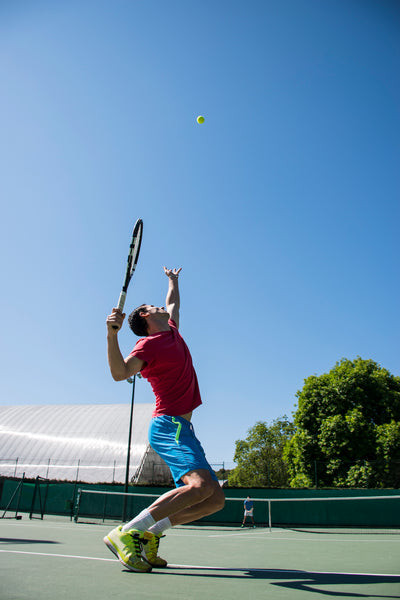The serve in professional tennis is more than just the start of a point; it’s a display of raw power, pinpoint accuracy, and cutting-edge technique. For fans and athletes alike, the quest to unleash the Tennis Fastest Serve Ever is a constant source of fascination. This article dives deep into the thrilling world of record-breaking serves, spotlighting the players who’ve pushed the boundaries of speed and the technology that measures these incredible feats.
The Lightning Bolts: Men’s Fastest Serve Records
In the realm of men’s tennis, the serve has evolved into a formidable weapon. Towering figures and athletic prowess combine to produce serves that can leave opponents stunned. Let’s explore the elite players who hold the top spots for the fastest serves ever recorded.
| Rank | Player | Speed (km/h) | Speed (mph) | Event | Year |
|---|---|---|---|---|---|
| 1 | Sam Groth | 263.0 | 163.4 | 2012 Busan Open Challenger | 2012 |
| 2 | Albano Olivetti | 257.5 | 160.0 | 2012 Internazionali Trofeo | 2012 |
| 3 | John Isner | 253.0 | 157.2 | 2016 Davis Cup | 2016 |
| 4 | Ivo Karlović | 251.0 | 156.0 | 2011 Davis Cup | 2011 |
| 5 | Jerzy Janowicz | 251.0 | 156.0 | 2012 Pekao Szczecin Open | 2012 |
Sam Groth, an Australian player known for his booming serve, officially holds the record for the fastest tennis serve ever recorded in a professional match. His serve of 263 km/h (163.4 mph) at the 2012 Busan Open Challenger remains unchallenged. This incredible speed underscores not only Groth’s exceptional serving ability but also the advancements in sports technology that allow us to measure such velocity with precision.
Albano Olivetti, John Isner, Ivo Karlović, and Jerzy Janowicz round out the top five, each boasting serves exceeding 250 km/h (155 mph). These players are not just about power; their serves are strategically crafted to be both fast and difficult to return, making them incredibly effective on the court.
Andy Roddick: A Serving Legend
Before the era of Groth and Isner, Andy Roddick was synonymous with serve dominance. While his fastest recorded serve of 155 mph doesn’t break into the current top five fastest serves, Roddick’s serve was legendary for its consistency and sheer power. It was the bedrock of his game, enabling him to control service games and apply immense pressure on his adversaries. Roddick’s serve was a major factor in his US Open victory and his consistent presence at the top of men’s tennis.
Women’s Serve Speed: Power and Progress
The fastest tennis serve female records are equally impressive, demonstrating the increasing power and athleticism in women’s professional tennis. Georgina Garcia Perez currently holds the women’s record, setting a new benchmark for serve speed in the women’s game.
| Rank | Player | Speed (km/h) | Speed (mph) | Event | Year |
|---|---|---|---|---|---|
| 1 | Georgina García Pérez | 220.0 | 136.7 | 2018 Hungarian Ladies Open | 2018 |
| 2 | Aryna Sabalenka | 214.0 | 133.0 | 2018 WTA Elite Trophy | 2018 |
| 3 | Sabine Lisicki | 210.8 | 131.0 | 2014 Stanford | 2014 |
| 4 | Venus Williams | 207.6 | 129.0 | 2007 US Open | 2007 |
| 5 | Alycia Parks | 207.6 | 129.0 | 2021 US Open | 2021 |
Georgina Garcia Perez’s serve of 220 km/h (136.7 mph), achieved at the 2018 Hungarian Ladies Open, is a testament to the growing power in women’s tennis. This record highlights the incredible strength and technique of modern female players.
Aryna Sabalenka, Sabine Lisicki, Venus Williams, and Alycia Parks complete the top five, showcasing a range of powerful servers who have consistently pushed the boundaries of serve speed in women’s tennis. Venus Williams, in particular, has been known for her powerful serve for decades, proving that serve velocity is a crucial element in the women’s game as well.
2024 Serve Speed Leaders: New Generation of Power Servers
The 2024 tennis season has already witnessed some blistering serves, indicating that the pursuit of speed is stronger than ever. Ben Shelton currently leads the pack in 2024 with an astonishing serve recorded at the Indian Wells Masters.
| Player | Fastest Serve Speed | Tournament |
|---|---|---|
| Ben Shelton | 241.4 km/h (150 mph) | 2024 Indian Wells |
| Pavel Kotov | 230.0 km/h (142.9 mph) | 2024 Italian Open |
| Alexander Zverev | 218 km/h (135.5 mph) | 2024 Australian Open |
| Daniil Medvedev | 211 km/h (131.1 mph) | 2024 Australian Open |
| Jannik Sinner | 210 km/h (130.5 mph) | 2024 Australian Open |
Ben Shelton’s serve of 241.4 km/h (150 mph) at the 2024 Indian Wells ATP 1000 Masters tournament demonstrates the emergence of a new generation of power servers. His serve, along with those of Pavel Kotov, Alexander Zverev, Daniil Medvedev, and Jannik Sinner, highlights the consistently high serve speeds at the top levels of tennis today.
Australian Open 2024 Semifinals: A Serving Showcase
The 2024 Australian Open semifinals provided a captivating glimpse into the power-serving elite. The players in the semifinals unleashed some of the fastest serves of the tournament.
| Player | Fastest Serve Speed |
|---|---|
| Alexander Zverev | 218 km/h (135.5 mph) |
| Daniil Medvedev | 211 km/h (131.1 mph) |
| Jannik Sinner | 210 km/h (130.5 mph) |
| Novak Djokovic | 208 km/h (129.2 mph) |
Alexander Zverev led the semifinalists with a 218 km/h serve, closely followed by Daniil Medvedev, Jannik Sinner, and even the legendary Novak Djokovic, proving that powerful serving is crucial even for all-court players. These speeds underscore the importance of serve velocity in modern tennis, especially in high-stakes matches.
The Science Behind Speed: Factors Influencing Serve Velocity
What factors contribute to these incredible serve speeds? It’s a combination of physical attributes, technique, and technological advancements.
- Height and Leverage: Taller players naturally have an advantage. Their height allows for a greater reach and a steeper angle when hitting the serve, increasing power and downward trajectory.
- Racquet Technology: Modern tennis racquets, particularly those from brands like Tecnifibre and Wilson, are engineered to maximize power transfer. Materials and designs enhance swing speed and ball acceleration.
- Radar Gun Precision: The accuracy of serve speed measurement has dramatically improved with sophisticated radar gun technology. Governing bodies like the ATP have standards for equipment, ensuring reliable and consistent measurements across tournaments. This technology allows for precise tracking of serve velocity, leading to official records.
Beyond Speed: The Art of the Serve
While raw speed is captivating, the most effective serves in tennis are not solely about velocity. Accuracy, spin, and strategic placement are equally vital. A well-placed serve with spin can be more challenging to return than a purely fast serve that lacks precision. Top players master the art of varying their serves, combining speed with placement and spin to keep opponents off balance.
 Fastest Tennis Serves – Racquet Point
Fastest Tennis Serves – Racquet Point
Conclusion: The Future of Fast Serves
The quest for the fastest serve in tennis continues to drive innovation and captivate audiences. As technology advances and training methods evolve, we can anticipate even faster serves in the future. The ongoing pursuit of serve speed not only highlights the physical capabilities of elite athletes but also the dynamic and ever-evolving nature of tennis itself. Whether you call it the fastest or the quickest serve, this aspect of the game will undoubtedly remain a focal point for players and fans for years to come.
References: Wikipedia.com, ausopen.com
Updated June 9th, 2024



